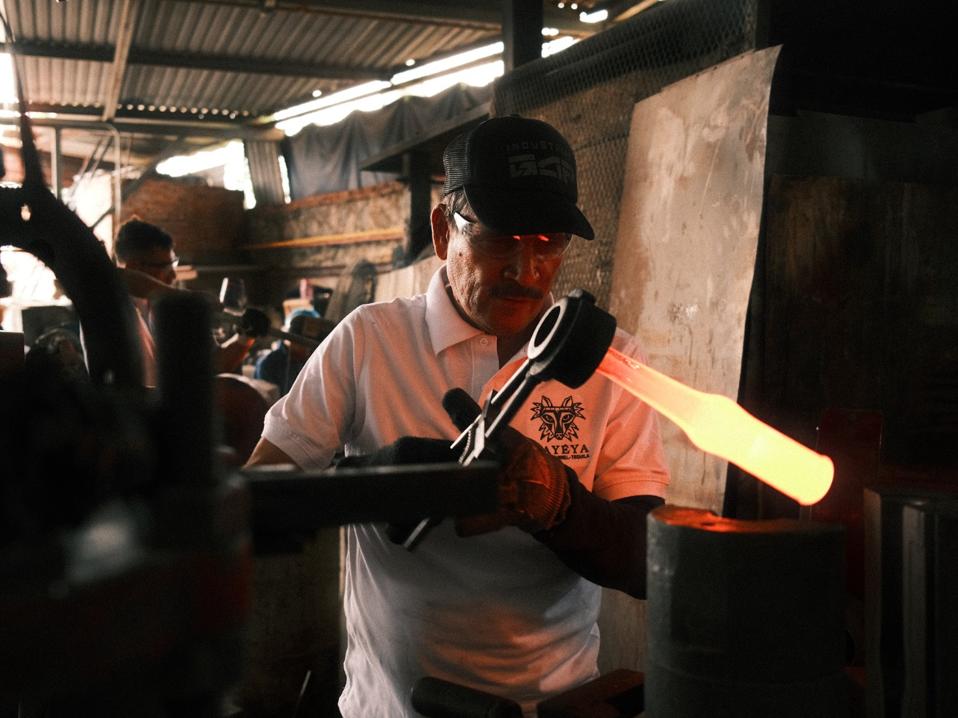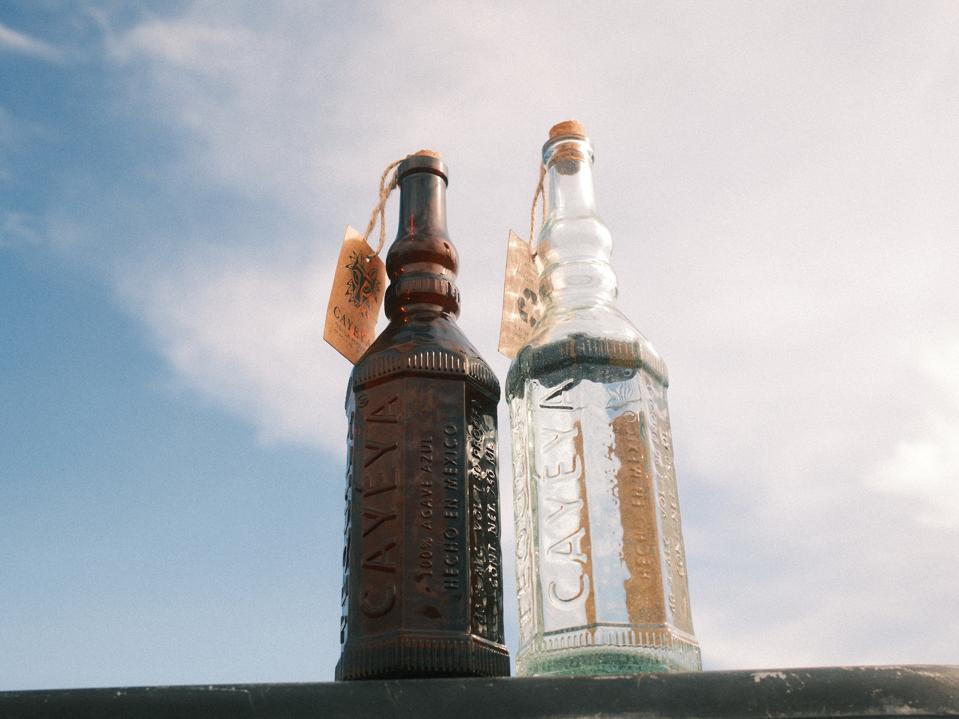Tequila brand Clase Azul is known more for its approach to bottling than for the tequila itself. It’s awfully difficult to get yourself to throw out the hand-painted ceramic bottle once it’s empty because of how beautiful they are.
Tequila Cayéya is also approaching its packaging in a creative way that’s sustainable and gives back to the Mexican economy. It uses recycled Mexican Coca-Cola and Pacifico beer bottles to create the glass for its new line of tequila.
Sustainable Sourcing
About 30 minutes outside of Guadalajara, Mexico is the city of Tonalá , which is known for its artisanal crafts and homemade glassware. Cayéya founder Sam Hirsch took a trip to a family-run glass factory there as he began developing the new, more traditional line of tequila under the brand. “I knew the second I walked in that I wanted to produce something there with them,” Hirsch says.
What Hirsch found so appealing about working with these glass producers, who wish to remain anonymous, was the handmade look to the bottle that the factory was able to achieve. “It looks like it fell off of a pirate ship,” he says. Every bottle has its own unique blemishes and slightly different blue-green tints that make each different from the rest. The exposed cork that seals the bottle is purchased from a Mexican producer who sources them from French and Italian wine producers. The only other material on the bottle is a small label with regulatory information and a hang tag, both made of recycled paper.
Recycled Mexican Coke bottles are melted into molten glass
Tequila Cayéya
The factory receives the Coke bottles from a recycling plant which shatters them and sends the remnants in large canvas bags. There’s no worry that there will ever be a shortage of materials because ”Mexican Coca-Cola here is like water,” Hirsch explains. “You see those traditional glass bottles all over, almost more commonly than plastic.”
The bottles are not made on automated production lines. “Being hyperlocal to where our distillery is, we’re able to produce at-will in really small batches,” Hirsch says. Using a manual steel mold, workers reduce the shattered Coke bottles into molten glass, then blow air into it using another machine so that it expands into the proper shape. Each bottle is then extracted via a metal rod to cool in a brick oven.
While the Mexican Coke bottles are used to bottle the traditional blanco, the company uses Pacifico beer bottles for its traditional reposado blend, which is aged in American and French barrels, to differentiate the two. These bottles of reposado are created the same way as the blanco bottles, just using a different source recycler.
Sustainability Sells
At a $49.99 price point online, Cayéya’s “traditional” lineup is designed to be more of your everyday, agave-forward tequila. This compares to its single-barrel lineup which has been on the market since the inception of Cayéya in 2021. Running between $129.99 – $159.99, these varietals are aged in non-traditional barrels such as Caribbean rum casks and Japanese whiskey casks and come in magnetic gift boxes with suede rope and a pewter label of the company’s feline-like logo.
Tequila Cayéya reposado and blanco blends
Tequila Cayéya
Cayéya has no direct relationship with Coca-Cola or Anheuser-Busch Inbev (which produces Mexican Pacifico), so you wouldn’t know for sure what the bottles are made out of just from seeing them on the shelf. The nakedness of the embossed bottle serves as a subliminal hint that there’s a message behind it. “That’s our greatest marketing tool,” Hirsch says. According to Cayéya, 95% of it’s sales are done off-premise at establishments where you buy the whole bottle as opposed to ordering it in a drink at a bar.
“The younger generations are a lot more socially and environmentally active and want to be in the know,” says Richard Cadavid, spirits director at Kindred Spirits and Wine, which has locations across Connecticut. “More and more customers are now coming to me better educated and asking me, ‘Is this additive-free’?”
Hirsch finds it important to honor the jimadores, who work tirelessly to take care of the land where they grow agave, by putting an emphasis on sustainability. The little waste that the jimadores produce gave him the bug to want to do the same. “It’s kind of contagious,” he says.
“With the tequila renaissance and boom that we’re in the midst of, a lot of brands are very much focusing on the people themselves that are instrumental to bringing that bottle to a consumer’s hand in the US,” explains Josh Jacobs, CEO and co-founder of Speakeasy Co., an ecommerce platform for the beverage alcohol industry. “It ensures that profits are flowing into those local towns so that they can flourish as well on the backs of all their hard work.”
Cayéya is sold online and in boutique liquor stores across the Northeast, Mid-Atlantic region and Colorado. Retailers notice customers are preferring it to established brands like Casamigos and Patrón. “In the sea of the Goliath brands, Cayéya has been a David that is doing a great job competing with the big boys once people get a chance to try the brand and hear what it’s all about,” says Cadavid.
According to Jacobs, the majority of alcohol marketing executives believe that “brands are built through experiences. There has to be something unique, some sort of narrative that’s going to appeal to consumers.” From water carafes to vases, Cayéya’s traditional tequila bottles are being upcycled in the same vein as Clase Azul. “I had one customer tell me she has her olive oil in the bottle of blanco and her vinegar in the bottle of reposado,” Cadavid says, who has now done the same in his own kitchen.
The term “Cayéya” is a slang term in Latin that, according to Hirsch, translates to “disruptive.”


